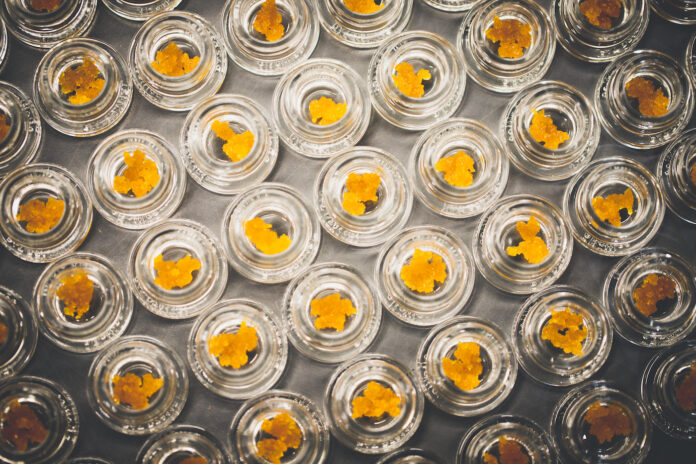Both solvent-based and solventless extraction methods have their defenders and detractors. For now, methods that use hydrocarbons like butane, propane, and ethanol are the most common, with advocates saying they provide efficiency at scale, are more versatile, and produce a purer product. But the hydrocarbons, also called volatile organic compounds (VOCs), are toxic and require purging with heat, which can destroy terpenes. They’re also flammable and can be dangerous in inexperienced or careless hands.
Commercial extractors large and small say commonly used solvents may have bad reputations, but modern closed-loop extraction systems make them much safer than they were twenty years ago. Hydrocarbons also make business sense: Butane and propane extraction are less expensive than other methods. The substances’ low boiling point preserves more of the hemp and cannabis compounds while effectively separating cannabinoids from the biomass.
Carbon dioxide, also a solvent, is non-toxic, non-flammable, and environmentally friendly, making it popular with extractors. When heated to a supercritical state, the compound becomes a liquid with a higher pressure and lower boiling point than water—only one degree cooler, but that’s enough to save delicate compounds. CO2 returns to gas at room temperature, making it among the easiest solvents to remove. Cultivators like CO2 as well, with some saying it leaves the cleanest taste.
Ethanol is one of the most widely used solvents for cannabis and hemp because it produces the highest yield. The alcohol hydrocaron derivative is uniquely “tunable,” meaning it can be heated to temperatures that target specific components.
On the other side of the debate are organic and craft cultivators and extractors—and a growing number of consumers—who believe solvents are bad for the body and the environment. They also maintain extracts processed with hydrocarbons are less pure, less concentrated, and do not taste as good as those processed without, but they admit solventless extracts are more expensive to make. Early adopters—usually health-conscious, affluent users—are willing to pay a premium for oils, wax, budder, sugar, sauce, and diamonds crafted to organic standards. The category is starting to trickle down-market, but it will take some time before most shoppers are willing to spend more for the products.
Organic-ish and regenerative farmers prefer to extract cannabis compounds and terpenes with heat, pressure, and agitation. These methods can squeeze trichomes from buds or shake them off without risk of fire or toxicity. The methods typically produce smaller yields, which means lower revenue, but solventless extracts rarely need a second pass to further refine or clean the end product. Solventless extraction produces the same types of products solvent-based processes do, with the exception of live resin. The analog in the solventless world is live rosin. Advocates say rosin contains more of the plant’s unique essence than solvent-based processes allow in resin.
There is some discussion about the amount of residual solvents and contaminants left in concentrates. Laboratories are supposed to test samples from every batch, but some producers have been accused of “lab shopping” for facilities likely to pass products that may exceed mandated limits. The few independent surveys and analyses of contaminant levels have found some products may contain more microbes, pesticides, and heavy metals than lab reports indicate. Unreliable reporting is especially a concern among medical patients, some of whom have compromised immune systems.
It’s worth noting that, despite the health implications of contaminants, there is no unified standard. Each of the thirty-eight legal states has its own regulations, resulting in a torturous maze of requirements that could be resolved with federal guidance to simplify compliance.
For example, Michigan’s regulations are widely praised for their rigorousness and consistency, and the state is seen as a model for others developing their own protocols. Michigan bans cannabis additives that are not approved by the Food and Drug Administration as an inhalant, while state-regulated labs test samples for potency, foreign matter, and other contaminants. At the other end of the spectrum, Florida’s safety regulations are limited, and testing is voluntary.
Extraction remains one of the most dynamic sectors in the cannabis industry. Companies are under pressure to keep their prices low, even as demand for concentrates soars. Vape cartridges are projected to corner 75 percent of the market by 2024, and more people, led by young users, are exploring super-concentrates. As those trends climb, flower’s popularity falls.
It’s all good news for processors of any persuasion who can scale up to meet the expanding demand—but only if they can process more than competitors and do so at a better price. In a hot market, experts warn “adapt or die” is more than an aphorism: Static extractors will be left behind.









